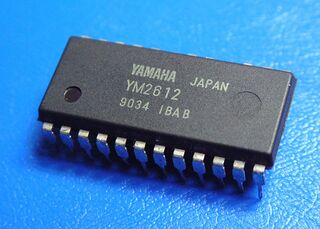YM2612
From Sega Retro

|
| YM2612 |
|---|
| Designer: Yamaha |
The Yamaha YM2612, also known as its designation OPN2 (and sometimes incorrectly called the "YM-2612"), is a sound chip by Yamaha that implements frequency modulation (FM) synthesis based on Yamaha's FM Operator Type-N (OPN) series. It is not the second OPN chip, however — the YM2203 (OPN), YM2608 (OPNA) and YM2610 (OPNB) are known to precede it. A CMOS version of the YM2612, the YM3438 (OPN2C), was also manufactured.
The YM2612 and its variants were notably used on the Sega Mega Drive game console. The chip was first released in 1988 alongside the console that it was originally developed for. It was also used in the Fujitsu FM Towns series of computers. Its use on the Mega Drive however meant that it was also used on hardware derived from it — including arcade boards such as the Sega System C and Sega System 32 arcade boards, where the YM3438 was used. Many revisions of the Mega Drive 2 also used the YM3438 core (with some minor changes) integrated into the main ASIC.
Details
OPN-based FM synthesis is very similar to other forms of Yamaha FM synthesis used in chips such as the YM2151, in that it consists of a number of operators connected in a variety of ways, with each operator consisting of a modified ADSR envelope, rate scaling, frequency multiplication, and detuning. By default, the chip can generate up to six simultaneous tones, each with their own configuration of FM operators. As with all OPN chips, the third channel can be modified to have each operator run at a different frequency — this is often called "special" or "multifrequency" mode. It also contains an SSG envelope generator (the YM2612 does not include the YM2149 [AY-3-8910 clone] core found in other OPN chips, but still retains its envelope generators directly on the core). Finally, there is a single sine-wave LFO which acts on all FM channels, but each channel can be set to be affected by it differently.
The YM2612 does not have a separate address and data bus. As a result, communication with the YM2612 is multiplexed on the 8-bit parallel bus. Each parameter the chip provides is accessed by first sending a register number to the chip, and then the register's value. Since Yamaha's register layout only allows up to four channels on a single register map, the YM2612 uses two ports on the chip to access each group of three channels.
The YM2612 also contains two timers — the high frequency Timer A and lower frequency Timer B. These timers can be set to interrupt a CPU when a timer reaches zero. Unfortunately, Sega never made these connections directly into the hardware of the Mega Drive, meaning that timers must be checked in software.
The sixth channel can be swapped out for a software-controlled 8-bit PCM channel (also known as the "DAC channel" or "DAC mode") mixed directly into the output waveform. In this mode, the controlling CPU must stream 8-bit unsigned PCM data to the YM2612 fast enough to be played back at the optimal playback speed. The maximum sample rate depends on the sample rate of the chip, but keep in mind that register writes must be synchronized to when the chip is ready — this is checked by polling the YM2612's status register and seeing if its Busy bit is set or not.
Unlike with most Yamaha FM sound chips, the YM2612 does not use an external DAC chip such as the YM3016 or similar to convert its digital signals into analog audio signals, and instead included a built-in DAC (not to be confused with the sixth channel's "DAC mode") to play back all six channels via time-division multiplexing, similar to the YM2413. A side effect to this approach is that it produces a form of crossover distortion known as low volume distortion, where each output that is low in volume exhibits some noticeable quantisation noise. Additional distortion may also be generated when playing sounds at very high volumes due to the limited dynamic range of the built-in DAC, leading to clipping issues. Later versions of the YM2612 such as the YM3438 reduced the presence of the low volume distortion bug by improving the built-in DAC of the original YM2612 design to allow for a more higher signal-to-noise ratio over the original chip design with less crossover distortion.
Because the YM2612 (and its OPN siblings) shares some similarities with other 4-operator FM chips such as the YM2151, the YM2612 is able to simulate sounds from the YM2151 as well as other Yamaha 4-operator FM chips with near-identical results, with some slight differences in the way the sound is produced. Conversely, the YM2151 (and other Yamaha 4-operator FM chips) is also able to replicate sounds from the YM2612 in a very similar fashion.
Technical specifications
- See Sega Mega Drive: Technical specifications for further information
- Clock rate:
- Sega Mega Drive: 7.670453 MHz (NTSC), 7.600489 MHz (PAL)
- Sega System 32: 8.053975 MHz
- Sound output: Mono, Stereo[1]
- Output frequency: 53.267 kHz (NTSC), 52.781 kHz (PAL)[2]
- Sound channels: 6
- Default configuration: 6 channels (6 FM channels)
- Alternative configuration: 6 channels (5 FM channels, 1 PCM channel)
- FM channels: 5-6 channels (5 channels with PCM, 6 channels without PCM)
- FM sample rate: 53.267 kHz (NTSC), 52.781 kHz (PAL)[2]
- LFO: 1 sine wave LFO (low frequency oscillator) channel
- IRQ interrupt capabilities: IRQ2 sound interrupt[7]
Documentation
External links
- YM3438 information, including official manuals (Japanese, link is now dead.) (Archived, incomplete)
- A transcription of Sega's incomplete, sometimes incorrect YM2612 documentation from the sega2.doc file
